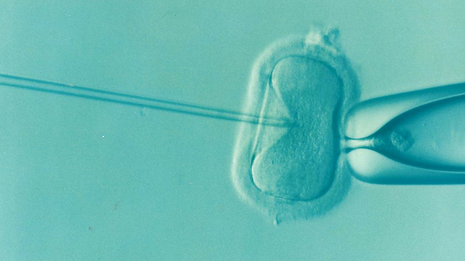Cambridge study named as ‘Breakthrough of the Year’
The research, which developed a new technique for the study of embryos, was given the accolade by Science magazine

Science magazine has named its People’s Choice ‘Breakthrough of the Year’ as a study led by Professor Magdalena Zernicka-Goetz from the Department of Physiology, Development and Neuroscience at the University of Cambridge.
Professor Zernicka-Goetz’s team developed an innovative technique which allows embryos to survive in vitro (outside of a living organism in a test tube or culture dish) for a longer amount of time, beyond the stage at which they would normally implant into the lining of the womb.
As a result of their work, scientists are now able to observe zygotes (fertilised egg cells) for up to 13 days after fertilisation, at which point UK law requires that studies are suspended.
It is hoped that, as a result of being able to observe embryos over this extended period, researchers can learn more about the stages of human embryo development, ultimately leading to improvements in IVF treatment and the prevention of pregnancy failure. As many as 70 percent of pregnancies fail over the time frame that the team are now able to study.
The study, published in the journal Nature in May, was nominated for the award by visitors to the magazine’s website, in a selection process comprising two rounds. The first narrowed a list of candidates down to a shortlist of five, from which voters were invited to choose their ultimate winner in the second round. The embryo study proved to be the most popular, winning 43 percent of the 225,000 votes.
“It’s a wonderful honour to have been given such public recognition for our work,” said Professor Zernicka-Goetz, speaking to Varsity. “It’s a natural human instinct to be curious about where we come from, but until now, technical hurdles have meant there’s been a huge gap in our understanding of how embryos develop. We hope that our technique will crack open this ‘black box’ and allow us to learn more about our development.”
Professor Zernicka-Goetz explained why she thought her work had captured the interest of the public so successfully: “I think it is as simple as the fact that people can relate to the importance of their own development – the human embryo has so much more meaning than the embryos of flies, frogs or even mice. We would all like to understand more about human development to be able to understand the beginning of our life and to improve the success of pregnancies.”
Reacting to the announcement, Professor Jim Smith, Director of Science at Wellcome, the charity that supported Professor Zernicka-Goetz’s work, said: “I’m really pleased to see Magda’s fantastic work recognised by Science, and we send our warmest congratulations to her and her team. In almost doubling the time we can culture human embryos in the lab, she has created completely new opportunities for developmental biologists to understand how we develop.”
The University has a long history of pioneering work in the field of human embryo research. In the same building that Professor Zernicka-Goetz worked in, Professor Sir Robert Edwards completed the first ever in vitro fertilisation of a human egg. His work laid the foundations for the development of IVF treatment and the first ‘test tube baby’, Louise Brown. He was awarded the Nobel Prize in Physiology or Medicine in 2010.
In the article that announced the People's Choice winner, Science magazine announced: “We made human embryo culture an area to watch because we expect it will result in new findings about early human development and also spark debate on whether time limits on culturing human embryos should be extended.”
Science magazine has been naming its 'Breakthrough of the Year' since 1989, to highlight the work of the world’s most pioneering scientists. The editor’s choice for the 2016 'Breakthrough of the Year' was the discovery of gravitational waves which warp spacetime, as predicted by Albert Einstein, which also came in as runner-up in the People’s Choice category. Previous winners include the discovery of the Higgs boson particle and the cloning of Dolly the sheep.
 Features / Pulling pints and making flat whites: the unspoken relationship between hospitality staff and Cambridge students17 June 2025
Features / Pulling pints and making flat whites: the unspoken relationship between hospitality staff and Cambridge students17 June 2025 News / Pembroke alumnus appointed as new head of MI617 June 2025
News / Pembroke alumnus appointed as new head of MI617 June 2025 News / Academics seek to restrict University’s use of injunctions 16 June 2025
News / Academics seek to restrict University’s use of injunctions 16 June 2025 News / 2025: The death of the May Ball? 13 June 2025
News / 2025: The death of the May Ball? 13 June 2025 News / SU overspends for second year in a row18 June 2025
News / SU overspends for second year in a row18 June 2025



